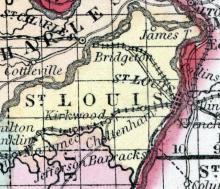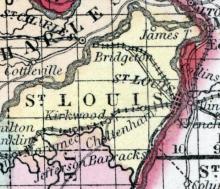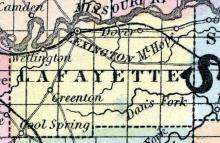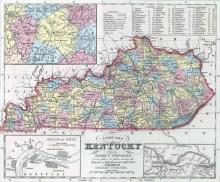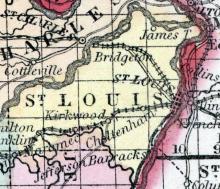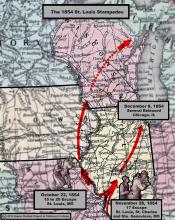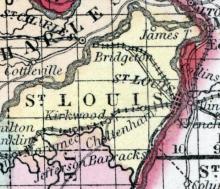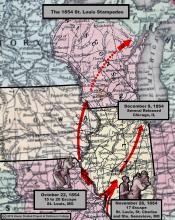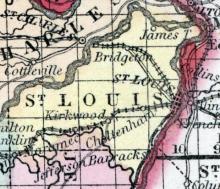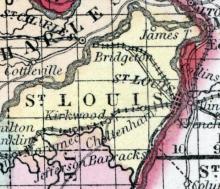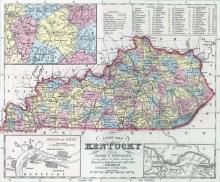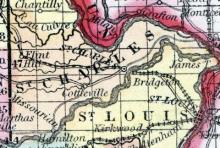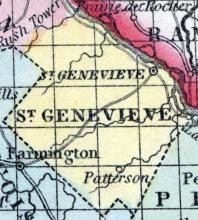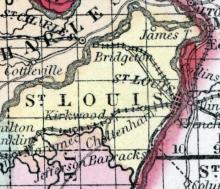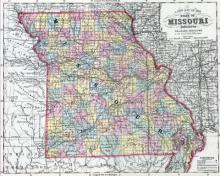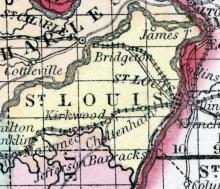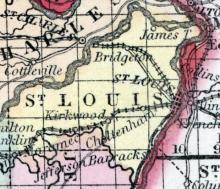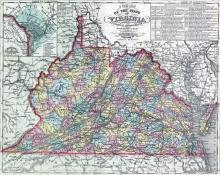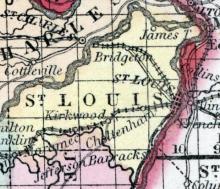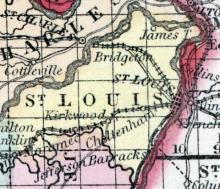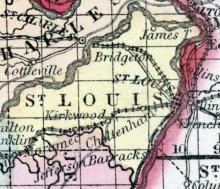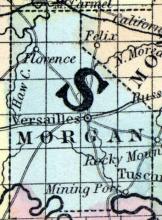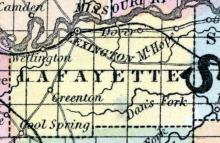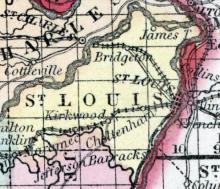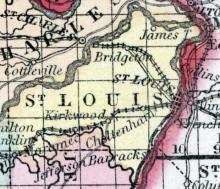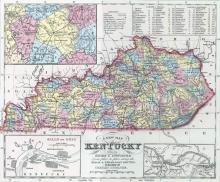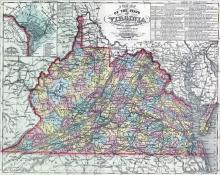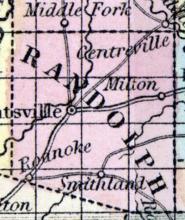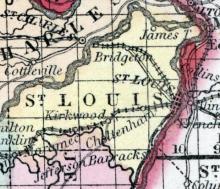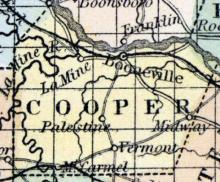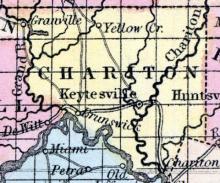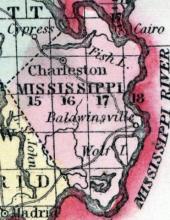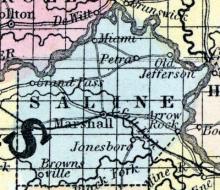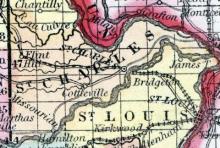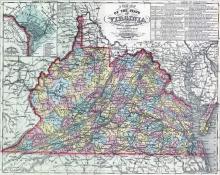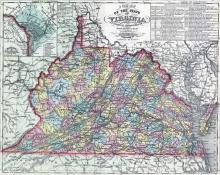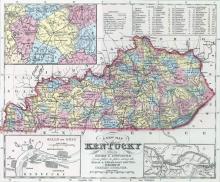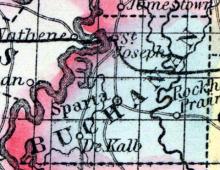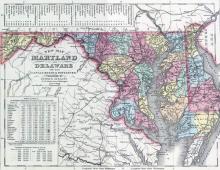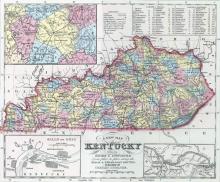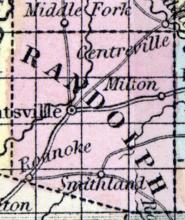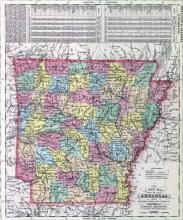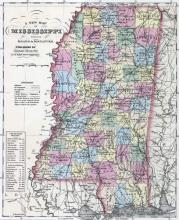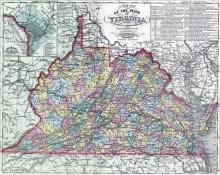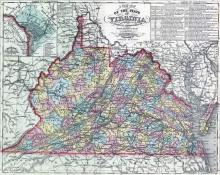On Monday, September 4, 1854, an enslaved man named Governor Scott, about 31 years old, escaped from slavery in St. Louis County. His enslaver, Richard Graham, offered $200 for Governor's recapture. At the same time, Governor's brother Henry Scott and 16-year-old nephew Washington Anderson escaped. The three men reached Chicago. Anderson later moved to Indiana, where a jury found him guilty of grand larceny. Graham's son-in-law, D.M.
View All Escapes // 1840s // 1850s // 1860s
Displaying 101 - 150 of 314
Two enslaved men, Henry and Washington, escaped from near Florissant, Missouri on Sunday, September 10, 1854.
In late September 1854, the Lafayette, MO Express reported a "stampede" of enslaved African Americans from the town of Dover, Missouri. Suspicion immediately fell upon several Jewish men, who had allegedly "tampered with" local enslaved people. A meeting of local slaveholders ordered the Jewish men to leave town. Then around early October, a group of the freedom seekers, enslaved by S.W.
On Saturday night, September 30, 1854, around six enslaved people escaped on horseback from Pendleton county, Virginia. Some were claimed by slaveholder and general James Boggs, a resident of Pendleton county. The freedom seekers' fate remains unknown.
On Saturday night, October 21, 1854, "another stampede" occurred from Bourbon county, Kentucky, in which around 15 enslaved people took flight. One freedom seeker was subsequently captured near Fairview, Kentucky, and two others were sighted, but not recaptured, days later near Mays Lick. The fate of the remaining freedom seekers remains unknown.
On October 21, 1854, a 14-year-old enslaved child named Dangerfield escaped from slavery in St. Louis. His enslaver, Thomas Skinker, advertised a $100 reward and speculated that Dangerfield "may possibly be yet in the city."
On Sunday night, October 22, 1854, a group of 15-20 enslaved Missourians escaped from St. Louis via boat and disembarked at Keokuk, Iowa, making their way across Wisconsin and reportedly to Canada. A month later, another large group escaped from the city and also liberated themselves. By December 1854, there was a sense of crisis among St. Louis slaveholders over "slave stampedes" and what they perceived as the escalating challenges to their tyranny over the enslaved.
On Thursday morning, November 16, 1854, a 23-year-old enslaved man named Aaron escaped. His enslaver, Lucy B. Russell, offered a $150 reward for his recapture.
On Friday night, November 24, 1854, ten enslaved people escaped from St. Louis. Their names were Lunsford Johnson, 26 years old, Emily (or Adeline), aged roughly 20 years, and her three children, 4-year-old Ellen, 2-and-a-half-year-old Belle, and one-year-old Edmund. They were joined by a 26-year-old man named Spencer, a 27-year-old man named David and perhaps three others. They reached Chicago at the same time as four freedom seekers from St. Charles and three more from Ste.
On Saturday night, November 25, 1854, four enslaved people escaped from Central Township near St. Louis: 30-year-old Nathan, his wife Betsy "supposed" to be with him, Bill or Burl, aged 21 years, and Ned, around 24 years old. Their enslaver, Elizabeth Smith, advertised a $500 reward for their recapture.
Around Sunday, November 26, 1854, an enslaved woman named Betty, in her early 30s, escaped from St. Louis in company with her twenty-month old child, "which has a large head." Her enslaver, James C. Delancey, advertised a $100 reward for her recapture.
On Sunday evening, November 26, 1854, eight enslaved people--five men and three women--escaped from bondage in Bourbon county, Kentucky. Crossing the Ohio river aboard two skiffs, they reportedly passed through Cincinnati en route for Canada. Their enslaver, James Hatfield, pursued them to Cincinnati on Tuesday, November 28, but returned to Kentucky after learning that the freedom seekers were long since gone.
Around Sunday, November 26, 1854, four enslaved people escaped from St. Charles, apparently in coordination with two near-simultaneous group escapes from Ste. Genevieve and St. Louis (described as a second "stampede" from St. Louis in just over one month). They reached Chicago in early December, and gained their freedom following a botched rendition attempt under the 1850 Fugitive Slave Law.
Around Sunday, November 26, 1854, three enslaved people escaped from St. Genevieve and successfully made their way to Chicago. This group escape appears to have been coordinated with two near-simultaneous escapes from St. Louis and St. Charles that altogether constituted a second "stampede" from St. Louis in just over one month.
On Monday, December 4, 1854, a 20-year-old enslaved man named Moses escaped from St. Louis. His enslaver, W.G. Gibbs, advertised a $200 reward for Moses's recapture.
On Sunday, December 24, 1854, two enslaved men, Richard Wash and Robert Jones escaped from the steamboat Tropie, while it was docked at Cairo, Illinois. Their enslavers, Henry E. Moore of Boonville, Missouri and B.M. Lynch of St. Louis, advertised a $250 reward for their recapture.
In early 1855, two enslaved Missourians were recaptured aboard a train outside of Sandoval, Illinois. The pair of freedom seekers had been reportedly "abandoned" by abolitionists, and were recaptured and taken to Cairo, Illinois.
On Saturday night, January 27, 1855, a "serious stampede" rocked Richmond, Virginia. Five enslaved people, among them Bob, Joe, and Linsey, escaped for "parts unknown," armed with $1,500 in cash taken from one of their slaveholders. Indeed, Bob, the enslaved man who fled from the slave trading firm of Jones & Slater had "enjoyed their fullest confidence," and was entrusted with making regular bank deposits for the slave traders.
On Thursday, February 15, 1855, 40-year-old Sarah escaped from slavery with her ten-year-old son Dick after their slaveholder, Legrand F. Rucker, died. The executor of Rucker's estate, Joseph H. Locke, advertised $300 for their recapture.
On Sunday night, February 18, 1855, six enslaved people, a man, woman and four children, escaped from prominent St. Louis slaveholder John O'Fallon. Missouri papers speculated that the freedom seekers were "on the way to Chicago."
On Tuesday, February 20, 1855, days after the escape of six enslaved people from slaveholder John O'Fallon, three more enslaved people escaped from St. Louis. Two were held by a Mr. Coleman, a few miles from St. Louis on the Bonhomme road, while another was enslaved in St. Louis itself.
On Tuesday, February 20, 1855, two enslaved people escaped from Richmond, Virginia, on the heels of another "stampede" of five freedom seekers the previous month. Their fate is unknown.
On Saturday morning, March 31, 1855, a 16-year-old enslaved woman escaped from St. Louis. Her name is unrecorded. Her enslaver, William Few, advertised requesting information regarding her whereabouts.
In one night in early April 1855, six enslaved people escaped from St. Louis.
On Sunday April 22, 1855, two enslaved men, William Taylor and William Bruce, escaped from slaveholder John Lay's property three miles outside St. Louis on the Central Plank Road. Lay advertised an $800 reward for their recapture.
An enslaved man named Jackson, also called Bob by his enslaver, escaped from Versailles in Morgan county, Missouri. His enslaver, Francis L. Ross, advertised a $50 reward for Jackson's recapture.
Around mid-May 1855, four enslaved people, 23-year-old Don, 30-year-old Hal, 28-year-old Bill, and 40-year-old Randall, escaped from near Lexington, Missouri. Their enslaver, Nathan Corder, advertised a $400 reward for their recapture.
On Sunday evening, May 21, 1855, around eight enslaved Missourians escaped via boat from St. Louis, with the aid of Mary Meachum, a prominent free African American in the city. However, authorities were waiting on the opposite shore, and five of the escapees were recaptured. Meachum and two other free blacks were later charged with assisting the escapees to flee.
On Sunday, May 20, an enslaved man named Jim Kennerly, around 20 years old, escaped from slaveholder Henry Shaw's "country residence" outside St. Louis. Shaw advertised a $300 reward for Jim's recapture. This episode was part of the 1855 St. Louis Stampede.
On Sunday, May 20, 1855, a roughly 22-year-old enslaved man named Ben escaped from St. Louis. His enslaver, H.H. Cohen, advertised a $100 reward for his recapture. This episode was part of the 1855 St. Louis Stampede.
On Wednesday night, June 6, 1855, a group of enslaved people escaped from the Byrnes plantation in Bourbon county, Kentucky. When the slaveholder, Byrnes, attempted to stop the escape, a violent confrontation ensued, where the enslaver was "severely handled" and left unconscious on the ground. The number of freedom seekers, or their names, were not recorded, but they reportedly crossed the Ohio river "about ten miles below" Cincinnati.
On Saturday night, June 16, 1855, five enslaved people escaped from Norfolk, Virginia. Attempting to escape aboard a northern-bound ship, they were betrayed and turned over to local authorities. Then on Sunday morning, June 24, another group of 15 freedom seekers escaped by boat from Norfolk. Their fate is unknown, but later in September several freedom seekers from Norfolk appeared in Syracuse, New York. They may have been from this second group of runaways.
Three enslaved people, Fayette, Madison and Thomas, escaped from St. Louis sometime during the mid-1850s, and settled in Chicago. The slaveholder who claimed Fayette and Madison, a man named Peter Camden, tried repeatedly but unsuccessfully to recapture the three escapees.
On Sunday July 29, 1855, three enslaved men, Henry Corder, Bill Coger, and Sam, escaped from Boonville, Missouri. Their enslaver, Henry E. Moore, offered a $450 reward for their recapture.
An enslaved man named Joseph fled from slaveholder Thomas Rodney in August 1855, boarding the Illinois Central Railroad at Cairo and riding the train to Chicago. Joseph was never recaptured, but an irate Rodney sued the railroad in Illinois state court, but lost.
Three enslaved people, a 24-year-old man, an 18-year-old woman, and another woman of unspecified age, escaped from Arrow Rock in central Missouri. Their enslaver, James W. Dickinson, advertised a $100 reward for their return.
An enslaved man named Jim escaped from Flint Hills, Missouri, reportedly making his way into Calhoun county, Illinois, along with a "man called Irish John or John Doyle." His enslaver, B. English advertised a $500 reward for his recapture.
On Sunday, August 19, 1855, six freedom seekers, who were not named, escaped from Piedmont, Virginia. They fled from enslavers Isaac Parsons, G.W. Blue, G.W. Washington, William Donaldson, and Isaac Baker. Their fate remains unknown.
In the span of about two weeks in early September, around 15 to 20 enslaved people escaped from Loudon county, Virginia, in what a local paper called a "wholesale stampede." The names of the freedom seekers were not recorded, but four individuals escaped from slaveholder John M. Harrison, three from a man named Skinner, three from a slaveholder named Stevenson, two from Joseph Lodge, and one from Cornelius Vandoventer, one from Joseph Meade, one from C. R. Dowell, one from Dr. F.
During the late summer and early autumn of 1855, there were numerous "stampedes" from Trimble county, Kentucky. A Madison, Indiana newspaper reported that there were "almost daily" escapes, and noted the escape of two freedom seekers held by Dr. William Ely of Milton, Kentucky.
On Saturday night, September 15, 1855, a group of freedom seekers escaped from near Chestertown, Maryland, traveling via three horses and a carriage. Accounts vary about the size of the group, alternating between 10 and 21 people.The freedom seekers passed through Rochester, New York, where Frederick Douglass announced in his newspaper that he had "the pleasure of shaking seven of them by the hand," before the freedom seekers reportedly journeyed on to Canada.
Between Friday night, September 21 to Tuesday September 25, the Louisville Courier tallied seven enslaved people who had escaped from near Louisville, Kentucky. The ultimate fate of the seven freedom seekers remains unknown, but the "regular and constant stampede" clearly unnerved Louisville's slaveholding class.
On Sunday, September 23, 1855, a 36-year-old enslaved man named Charles escaped from Huntsville in Randolph county, Missouri. His enslaver, James H. Britton, advertised a $150 reward for Charles's recapture.
Sometime in early October 1855, 11 enslaved people escaped from Ouachita county, Arkansas. A "general stampede among the negroes" was feared, and slaveholders feared "a concert of action" among local enslaved people. The fate of the 11 freedom seekers, however, remains unknown.
In October 1855, a correspondent to the Vicksburg, Mississippi Whig mentioned a "general stampede" of "some ten or fifteen" enslaved people from near Raymond, Mississippi. The enslaved people had apparently been hired out ("or rented") by slaveholders in Raymond, and the "stampede" may have been connected to a fever outbreak.
On Saturday night, October 27, 1855, seven enslaved people broke open a locked door and escaped from the slave pen of Jones & Slater in Richmond, Virginia. Three of the freedom seekers had been arrested previously, after attempting to escape from Bath county, Virginia. They were slated to be sold south.
Sometime in November 1855, a group of freedom seekers escaped from Union in Monroe county, Virginia. The number of runaways was not specified, nor were their names recorded, but reports did specify that the slaveholder, J.L. Hutchinson, lost $2,000 in human "property."

